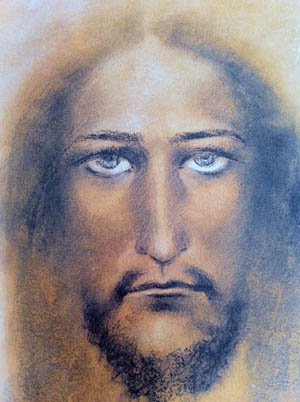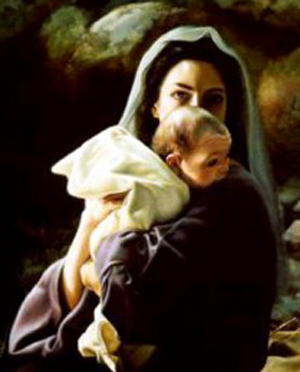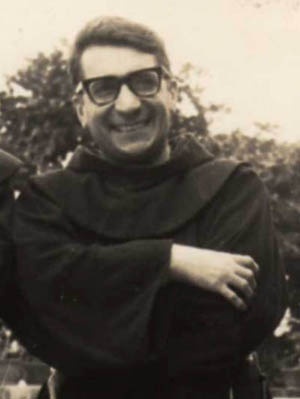 |
Book Reviews
Valtorta’s Poem of the Man-God
Marian T. Horvat, Ph.D.
Book review of Peom of the Man-God by Maria Valtorta, 10 volumes, online edition
A friend recently sent me an e-mail asking about Maria Valtorta and her Poem of the Man-God. She received a recent issue of Kyrie Eleison comments of Bishop Richard Williamson titled “Home Reading” (October 20, 2012). In it, he recommends parents read selected chapters of the Poem of the Man-God to children every night.
He admits the Poem is controversial and has many enemies, but he defends Valtorta’s massive tome (4,000 pages in 10 volumes of supposed visions she received of the life of Christ). The Bishop supports it, despite the objections he lists: that it is riddled with doctrinal errors, that it humanizes Our Lord Jesus Christ, and that the work was placed on the Church’s Index of Forbidden Books in the 1950s.
He lightly dismisses all the arguments against it and concludes children will learn much about Our Lord and Our Lady from the Poem, which “will fortify a home.”
“I have not read this book,” my friend continues, “but, for Heaven’s sake, why didn’t Bishop W. recommend reading the wonderful, approved, written-by-a-canonized saint 4-volume City of God by Mother Mary of Agreda? But that is beside the point. I really do wish to know if you approve of the Poem of the Man-God. Even the title upsets my Catholic sensibilities.”
A humanized Christ
I believe my friend should follow her good Catholic sense. The very title, the Man-God , expresses the spirit of the work. It is Jesus as a man that Valtorta presents: a babe suckling greedily at his Mother’s breasts, a youth hardly aware of Who He is, a Man who laughs and jokes with His Apostles and is constantly kissing them on the mouth and embracing them closely. Yes, at the least, it is difficult not to suspect this showy Jesus pictured in such way as having homosexual tendencies.
Valtorta’s natural approach is supposed to attract the modern man to the Life of Christ. It is in tune with the progressivist doctrine that tries to deny the supernatural and instead presents Our Lady as a simple Jewish woman and focuses on Our Lord as being a man “like us.” As Atila Guimaraes points out in Animus Injuriandi I, the progressivist Church aims to de-mythify and de-supernaturalize Christ and His Mother under the guise of presenting a natural “historical” Christ and Mary.” I believe Valtorta’s Jesus and Mary fit this mold.

An illustration of Valtorta's Jesus, a somewhat occult figure with a magnetic gaze |
Valtorta’s Man-God depiction is the opposite of the God-Man portrayed by Anne Catherine Emmerich and Ven. Mary of Agreda, whose life of Christ is presented from an elevated, supernatural vantage point. One cannot help but wonder why the traditionalist Bishop would not recommend these works, instead of the Valtorta tomes, which were officially condemned by the Holy Office and placed on the Index in December 1959 and defined by L’Osservatore Romano of January 6,1960 as “a badly fictionalized life of Jesus.”
After Vatican II, Paul VI abolished the Index of Forbidden Books, and Valtorta’s supporters claim this nullifies the suppression of 1959. Unfortunately, the official position of the Church today is less than clear, with important Prelates and Catholic figures on both sides of the issue. Obviously, the progressivists, almost to the man, defend it.
The Poem of the Man-God, I believe, is riddled with banalities, vulgarities, blasphemies and even doctrinal errors. There are endless idle conversations between Our Lord, Our Lady and the Apostles, all on a natural level. I think the best way to confirm these points is simply to cite some texts, which are so revolting that they speak for themselves.
The quotes that follow are taken from an online edition of The Poem of the Man-God. A 48-page critique written in the 1980s – when the Poem’s popularity surged for a period, as it seems to be resurging now – by a Salesian, Brother James, S.D.B., can be read in its entirety here (Vol. 1, Vol. 2, Vol. 3, Vol. 4, Vol. 5) .
An Infant conceived with original sin
Valtorta portrays the Christ Child as a greedy infant of a sentimental Mother. It is difficult to find the respect we owe to Our Lord Jesus Christ in this imaginary immodest description of a nursing scene:

The Man-God presents a naturalistic view of Our Lady and the Christ Child |
“Jesus opens His eyes, sees His Mother and smiles and stretches His little hands toward Her breast.
“[Mary] ‘Yes, love of Your Mummy. Yes. Your milk. Before the usual time. But You are always ready to suck Your Mummy's breast, My little holy Lamb!’
“Jesus laughs and plays, kicking His feet out of the blankets, moving His arms happily in a typical childish style, so beautiful to see. He pushes His feet against His Mummy's stomach. He arches His back leaning His fair head on Her breast, and then throws Himself back and laughs, holding with His hands the laces that tie Mary's dress to Her neck, endeavoring to open it. …
“Mary nurses Him and Jesus avidly sucks His Mother's good milk, and when He feels that only a little is coming from Her right breast, He looks for the left one, laughing while doing so and looking up at His Mother. Then He falls asleep again on Her breast, His rosy round little cheek resting against Her white round breast.” (Vol 1, n. 35, p. 106).
An Adult with homosexual tendencies
Valtorta’s Jesus suspiciously displays homosexual tendencies since he is constantly kissing and embracing the Apostles. When Jesus tells James of His approaching Passion, James reacts with great emotion. Jesus comforts him thus:
“’Come, I will kiss you thus, to help you forget the burden of My fate as Man. Here, I kiss your lips that will have to repeat My words to the people of Israel and your heart that will have to love as I told you, and there, on your temple, where life will cease.’ … They remain embraced for a long time and James seems to doze off in the joy of God's kisses that make him forget his suffering.”

Recently beatified Gabriel Allegra, a Teilhard de Chardin colleague, was a promoter of the Man-God Poem |
When Valtorta describes the “favorite” Apostle John as having the face of a young girl with the “gaze of a lover,” we can hardly avoid having the impression that they have a homosexual relationship. Here Jesus is kissing John to awaken him:
“Jesus bends and kisses the cheek of John, who opens his eyes and is dumbfounded at seeing Jesus. He sits up and says, ‘Do you need me? Here I am.’ …
“John, half naked in his under-tunic, because he used his tunic and mantle as bed covers, clasps Jesus’ neck and lays his head between Jesus’ shoulder and cheek.”
After John professes his belief and love in Jesus as Son of God, “he smiles and weeps, panting, inflamed by his love, relaxing on Jesus’ chest, as if he were exhausted by his ardor. And Jesus caresses him, burning with love Himself.”
John begs Jesus not to tell the others of what has passed between them. Jesus replies, “Do not worry, John. No one will be aware of your wedding with the Love. Get dressed, come. We must leave.” (Vol. 2, n. 165, pp. 57-58)
Jesus suggests a love-affair between St. Peter and Our Lady
Jesus even jokes with impropriety with his apostles. Here, Jesus stands up and calls out loudly and angrily to Peter:
“‘Come here, you usurper and corrupter!’
“‘Me? Why? What have I done, Lord?’
“‘You have corrupted My Mother. That is why you wanted to be alone. What shall I do with you?’
“Jesus smiles and Peter recovers his confidence. ‘You really frightened me! Now You are laughing.” (Vol. II, n. 199, p. 185)
Like Luther, Mary thinks: Let us sin to be forgiven
Some passages are tantamount to heresy. For example, Valtorta presents the child Mary as expressing her desire to be a big sinner in order to merit the grace of Redemption:
“[Mary]: ‘Tell Me, mummy, can one be a sinner out of love of God?
“[Anne]: ‘What are you saying, my dear? I don't understand you.’
“[Mary]:’I mean: to commit a sin in order to be loved by God, Who becomes the Savior. Who is lost, is saved. Isn’t that so? I would like to be saved by the Savior to receive His loving look." (Vol. 1, n. 7, p. 23).
A sensual Eve tending toward bestiality
The work is also not without doctrinal errors, such as when Valtorta asserts the sin of Eve was not disobedience, but a sexual act. There is also an insinuation of a tendency toward bestiality in Eve. This erotic description was supposedly made by Jesus:
“With his venomous tongue Satan blandished and caressed Eve’s limbs and eyes… Her flesh was aroused … The sensation is a sweet one for her. And ‘she understood.’ Now Malice was inside her and was gnawing at her intestines. She saw with new eyes and heard with new ears the habits and voices of beasts. And she craved for them with insane greed. “She began the sin by herself. She accomplished it with her companion.” (Vol. 1, n. 17, p. 49)
These are some excerpts I offer to my readers to evaluate Valtorta’s work. I believe they are sufficient for the reader to make a judgment of the whole.
It is thus understandable that the Holy Office placed the work on the Index of Forbidden Books,
which is reproduced below. It is also understandable that the Salesian Brother James concluded his critique of the first two volumes with these words: “Poem of the Man-Godis so demonic that without a special grace from Our Lord Jesus, we could be deceived by the seemingly harmless statements by Valtorta’s Jesus, but they enclose lies and heresy, contrary to the teachings of One, Holy Catholic Church.”
*
Supreme Congregation of
the Holy Office
Decree
Proscription of Books
Wednesday, December 16, 1959
The Most Eminent and Reverend Cardinals of the Supreme Congregation of the Holy Office, to whom the safeguarding of things of the Faith and Moral is confided, after receiving the previous opinions of the Consultors, have unanimously condemned and ordered that the books by an anonymous author, in four volumes, be inscribed in the Index of Forbidden Books, the first of those books being:
Il Poema di Gesù [The Poem of Jesus] (Tipografia Editrice M. Pisani);
followed by,
Il Poema dell'Uomo-Dio [The Poem of the Man-God], (Ibidem).
On Friday of that same month and year, the Most Holy and Dignified Lord John XXIII, Pope by the grace of Divine Providence, in an audience given to the Most Eminent and Reverend Cardinal Secretary of the Holy Office, after hearing the report of the Most Reverend Fathers, approved this resolution and commanded that it be published.
Given in Rome, in the seat of the
Holy Office on January 5, 1960.
Sebastian Masala, Notary

Posted October 29, 2012

Related Topics of Interest
 The Royalty of Christ the King The Royalty of Christ the King
 'Jesus 2000' - A New Model Ideal 'Jesus 2000' - A New Model Ideal
 Counter-Revolutionary Role of the Sacre Heart Counter-Revolutionary Role of the Sacre Heart
 Sacred Heart, Symbol of Combativity Sacred Heart, Symbol of Combativity
 The Transfiguration of Our Lord The Transfiguration of Our Lord
 The Two Advents of Our Lord The Two Advents of Our Lord

Related Works of Interest
|
|
Book Reviews | Home | Books
| CDs | Search | Contact Us | Donate

© 2002-
Tradition in Action, Inc. All Rights Reserved
|
 |

|